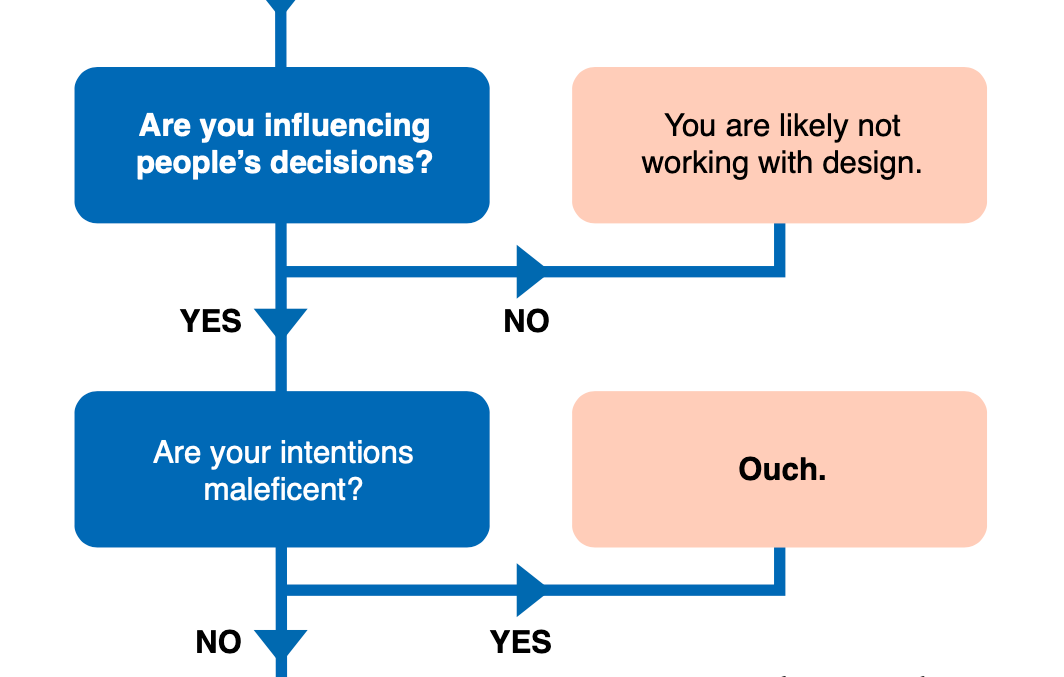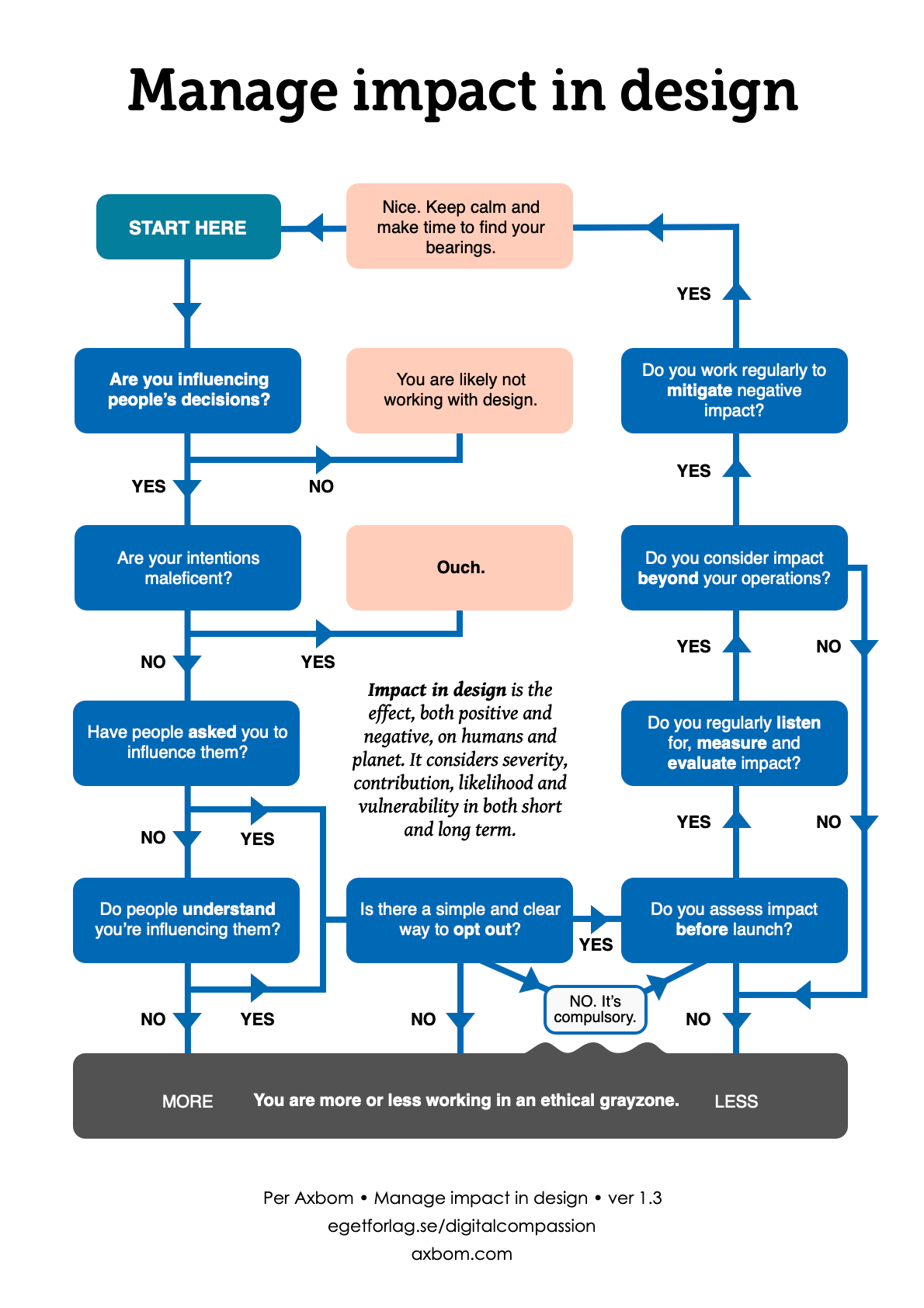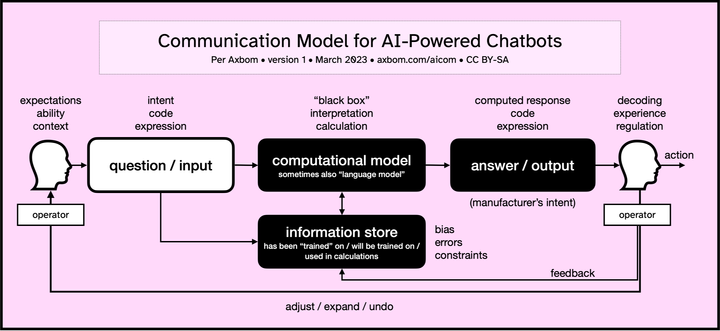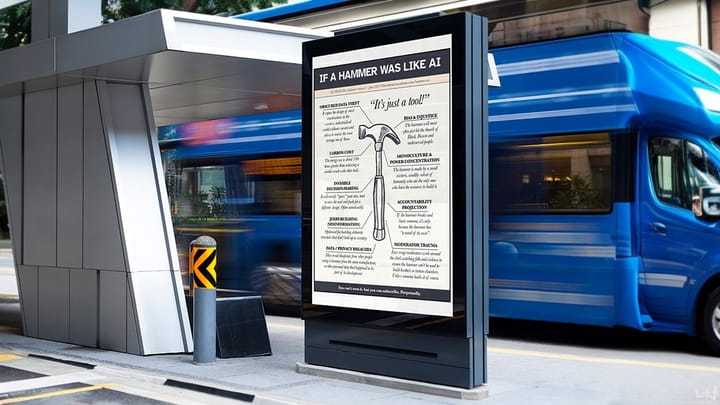Flowchart: Manage impact in design

The flowchart on managing impact is intended to give you an overview of the elements that help you avoid and mitigate negative impact in digital design. Of course, it likely makes sense for more design situations than digital ones.
I define impact like this:
Impact in design is the effect, both positive and negative, on humans and planet. It considers severity, contribution, likelihood and vulnerability in both short and long term.
With regards to the words in that definition, here is what they refer to:
- Severity – How bad (or good) is the effect?
- Contribution – If it happens, how much is by our making?
- Likelihood – How probable is it that the effect will happen?
- Vulnerability – How burdened are the people who experience the effect?
While there are no formal scales for assessing these parameters, they give guidance by allowing us to compare effects to each other and thereby provide input to decisions and prioritizations.
Now, in order to keep negative impact to a minimum, this flowchart provides an overview. Click here for a printable PDF version. Each step in the flowchart is explained below.

- Start here. The flowchart suggests you start in the top left.
- Are you influencing people’s decisions? This is essentially what design does, and so you need to start by acknowledging that you have an important responsibility – also considering how that may translate to accountability.
- Are your intentions maleficent? I’m obviously assuming that your intent is more of the good-natured kind, or otherwise you would have little interest in this content.
- Have people asked you to influence them? Consent is an important part of doing the right thing. And it’s not truly consent if it’s not informed. This means people understand what they have given consent to.
- Do people understand you’re influencing them? Supposing there is no explicit consent, you would have to be able to argue that there is implicit consent in the context of what you are doing. For example, at a magician’s show people have implicitly agreed to be influenced by attending the show and purportedly having an understanding of what magic constitutes. But assuming understanding without knowing they understand can be an ethical conundrum.
- Is there a simple and clear way to opt out? It’s not unheard of that some companies make it much harder to end a relationship than start it. In cases where people have invested effort into content that is hosted by an online service, the question of access to that data becomes an important aspect of opting out as well. To be considered ethical, organizations must make leaving simple, clear and without unnecessary obstructions.
- NO, it’s compulsory. There are situations where people have no options for leaving because a product or service is part of the workplace, school, organisation or governmental agency that they are required to have a relationship with in specific contexts. In these cases, it’s important to realize that adhering to the following principles of ethical design becomes wildly important as there is no way, or only a very difficult way (for example resigning) to avoid the service.
- Do you assess impact before launch? The key here is to make an effort to understand the many ways people could be harmed, before they happen. There is no way of understanding all potential future scenarios, but you will discover – and have an opportunity to mitigate – many more harmful scenarios if you look for them than if you do not. This can involve bringing in and talking to many different people, and allowing them and yourself to brainstorm on the potential risks. By mapping out potential harm beforehand you can avoid a lot of difficult and costly future decisions when a product or feature is live and doing its thing.
- Do you regularly listen for, measure and evaluate impact? Of course, once a service is released you can start to learn many new things about how it affects people and their well-being. Having mechanisms in place to gather data about impact, and evaluating how severe the effects are, is fundamental to being able to respond to material harm and working proactively to mitigate it.
- Do you consider impact beyond your operations? It’s easy to assume that you only have responsibility for your product and its immediate effects. But more often than not your product is part of larger context and (eco)system, and how it affects people’s lives may not be obvious. For a complete picture of your impact you need to be looking beyond direct use, at autonomy or freedom of choice. You must also understand how the making of your products requires external input: services, energy and labor with questionable safeguards from harm. Addressing these indirect contributions may at first feel counter-intuitive but will become vital in a global economy affected by resource-use, movement of people and climate in ways we have yet to anticipate.
- Do you work regularly to mitigate negative impact? With all the knowledge you have when employing these efforts you of course have to take the final step and act on them. Putting a plan in place for how and when you will work with your insights and act on them must in the end be ingrained within the culture of your organisation. Make sure you find your allies and employ help in setting this up.
Answers to these questions will help indicate if you are more or less are operating in an ethical grayzone. By starting at the top you can work your way through and identify your most obvious weaknesses. That way you get an idea of what you can start working with.
Remember to keep calm and make time to find your bearings. It’s rarely an easy task to shift to designing ethically. Try not to do everything at once, but instead to take small steps, one after the other, once you have your goal in sight. Thank you for reading and for walking with me on this path.




Comment